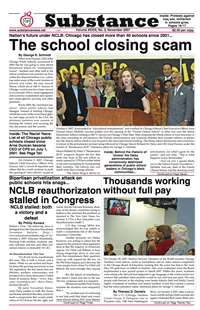KneeCAP the tests in Vermont?
Testing Season in Vermont
The NECAPs are coming, the NECAPs were coming. Oh, wait, they’ve passed, already.
From Monday, October 2 [2007] through Friday, October 19, NECAPS ruled. NECAP, the New England Common Assessment Program, is the standardized test Vermont was forced to adopt to get in line with federal NCLB requirements. Vermont used to test students several times in elementary school. Under NCLB, states must subject students to standardized tests in Reading and Math every year between grades 3 and 8 and once in high school. Writing is tested in 5th, 8th, and 11th.
Because tests that require actual writing rather than just multiple choice answers are inordinately expensive, Vermont joined with New Hampshire and Rhode Island to produce a common test, which was launched in 2005. Although the Vermont Department of Ed posts some test samples, New Hampshire’s NECAP website is much easier to navigate.
Since I have had occasion to see, first hand, the misery the writing test causes some students, that’s where I am focusing. The test fosters an odd notion of writing, rewarding only certain skills while degrading others. You can see this by looking at the 2007 Sample Writing Prompts:
Grade 5
Write a beginning paragraph of a scary story that describes the SETTING.
Use descriptive details in your writing.
Grade 8
[Picture of girl on phone, with family in background]
Look at the picture and then write a telephone conversation (dialogue) that reveals character traits of the girl on the cell phone. Use descriptive details in your writing.
Although these prompts offer plenty of room for pedagogical outrage from these prompts, I want to take a closer look at the Grade 11 writing prompt, which NECAP terms procedure writing.
Procedure
You have been assigned to help a new student have lunch in your school cafeteria for the first time.
Write a procedure explaining how to “successfully survive” the experience. You may include text features (headings, bullets/numbers, diagrams, etc.) to help the reader.
Planning/Review Box Questions
What does the reader need to know about this procedure?
What are the steps in this procedure?
How have you addressed potential problems that may beencountered while performing this procedure?
Take a look at sample Grade 11 essays, and you will see that students who are not hot air artists, students who get right to the point, are penalized. For example, one responder drew a careful 15-station diagram of where everything in the cafeteria is located: trays, fridge with cold drinks, coffee machine, grilled cheese, pizza, and so on through check out. He scored only three points, half the point allotment of the student who also drew a diagram, but labeled sections “Busy,” “Nice,” and “Okay.” This student also offered opinion, informing the reader which foods “suck.” A student receiving 5 points is a more talented writer, and his/her procedure for negotiating the cafeteria included a section titled “Social Politics in the Café.” This student also included a diagram. There’s not much about food here but it identifies the location of the nerd table, the jock table, and the special ed table. I haven’t a clue of why this is a “5” and not a “6.”
But I think I know why the kid who draws great diagrams received only a “3.” The difference in writing scores may well hinge on this criterion listed for a 6-point essay: intentionally organized for effect. The student who received three points delivered the goods, but he did not offer entertainment while doing it.
Our society needs all kinds of writers. I would argue that if you were going to the cafeteria for the first time you might want to know where you could find a grilled cheese sandwich.
We need students who can write directions for understanding the dashboard functions of a new car as well as those who entertain us with the sociological analysis of the highway system. And there are definitely times in our lives when one need is more pressing than the other. NECAP framers insist that a six-point essay must contain details/elaboration. I would argue that when you want to know how to operate the windshield wipers, you aren’t in the mood for elaboration. It seems curiously wrongheaded to educate students to believe that extra details are always the mark of good writing.
We must free ourselves of Federal intrusion, returning student assessments to local schools. Freed of a standardized system sent in from corporate conglomerates, teachers will be able to help individual students develop individual talents, not insisting that everybody needs to write scary stories or telephone dialogue.
Address all requests for explanation of the importance of the telephone dialogue writing skill to:
Measured Progress
100 Education Way
P.O. Box 1217
Dover, NH 03820
mail@measuredprogress.org
Or, if you think the person in charge of education in Vermont should be able to answer the question:
Superintendent Richard Cate
Vermont Department of Education
120 State Street
Montpelier, VT 05620-2501
richard.cate@state.vt.us
Maybe they can also explain the unfortunate acronym for the test, sounding more like a Mafia target than a testing instrument.



